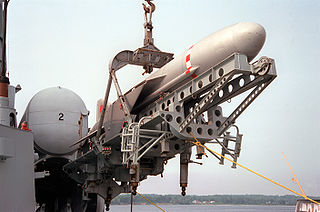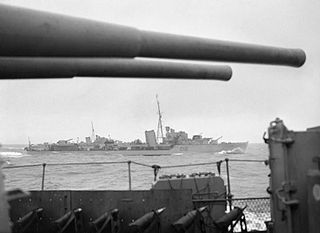
The P-15 Termit is an anti-ship missile developed by the Soviet Union's Raduga design bureau in the 1950s. Its GRAU designation was 4K40, its NATO reporting name was Styx or SS-N-2. China acquired the design in 1958 and created at least four versions: the CSS-N-1 Scrubbrush and CSS-N-2 versions were developed for ship-launched operation, while the CSS-C-2 Silkworm and CSS-C-3 Seersucker were used for coastal defence. Other names for this basic type of missile include: HY-1, SY-1, and FL-1 Flying Dragon. North Korean local produced KN-1 or KN-01, derived from both Silkworm variants and Russian & URSS P-15, Rubezh, P-20 P-22.

The Battle class were a class of destroyers of the British Royal Navy (RN) and Royal Australian Navy (RAN), named after naval or other battles fought by British or English forces. Built in three groups, the first group were ordered under the 1942 naval estimates. A modified second and third group, together with two ships of an extended design were planned for the 1943 and 1944 estimates. Most of these ships were cancelled when it became apparent that the war was being won and the ships would not be required, although two ships of the third group, ordered for the RAN, were not cancelled and were subsequently completed in Australia.

The Gearing class was a series of 98 destroyers built for the U.S. Navy during and shortly after World War II. The Gearing design was a minor modification of the Allen M. Sumner class, whereby the hull was lengthened by 14 ft (4.3 m) at amidships, which resulted in more fuel storage space and increased the operating range.

The Fletcher class was a class of destroyers built by the United States during World War II. The class was designed in 1939, as a result of dissatisfaction with the earlier destroyer leader types of the Porter and Somers classes. Some went on to serve during the Korean War and into the Vietnam War.

The Allen M. Sumner class was a group of 58 destroyers built by the United States during World War II. Another twelve ships were completed as destroyer minelayers. Often referred to as simply the Sumner class, this class was characterized by their twin 5-inch/38 caliber gun mounts, dual rudders, additional anti-aircraft weapons, and many other advancements over the previous Fletcher class. The Allen M. Sumner design was extended 14 feet (4.3 m) amidships to become the Gearing class, which was produced in larger numbers.

The Type 051 destroyer was a class of guided missile destroyers deployed by China. It was the first guided missile destroyer fielded by the People's Liberation Army Navy (PLAN), and the first designed and built in China. The class was based on the Soviet destroyer Neustrashimy. 17 were built from 1970 to 1990; it was not until the 21st century that China would again build a class in such large numbers.

The Type 052Luhu-class is one of the first modern multi-role guided missile destroyers built by China. There are currently two units in active service with the People's Liberation Army Navy Surface Force. It was succeeded by the Type 051B.

The Type 051B Luhai-class is a class of destroyer built by the People's Republic of China. It consists of only one ship, DD-167 Shenzhen. When Shenzhen was commissioned into the People's Liberation Army Navy Surface Force in 1998, it was then, the largest surface combatant that China had ever built. It resembles in many ways an enlarged version of the Luhu-class destroyer, and is one of the first PLAN ships with a slope-sided hull to reduce radar signature. The 051B was succeeded by the domestic Type 052B, discounting the 4 Soviet built Sovremennyy-class destroyer China purchased in the interim.

The Type 052B or Guangzhou class destroyer is a class of multirole missile destroyers built by the People's Republic of China. Two ships have been built, with Guangzhou (168) and Wuhan (169) both being commissioned into the People's Liberation Army Navy Surface Force in July 2004. This class features a stealthy hull and significantly improved air defence systems, an area that had been a major weakness on previous ships designed by China. These ships represent a major improvement over older generation vessels and reflects the PLAN's need for more modern destroyer designs.
The Type 052C destroyer is a class of guided missile destroyers in the Chinese People's Liberation Army Navy Surface Force (PLAN). The Type 052C introduced both fixed active electronically scanned array (AESA) radar and vertically launched surface-to-air missiles into PLAN service, making it the first PLAN warship with area air defence capability.

The Farragut-class destroyer was a group of 10 guided missile destroyers built for the United States Navy (USN) during the 1950s. They were the second destroyer class to be named for Admiral David Farragut. The class is sometimes referred to as the Coontz class, since Coontz was first to be designed and built as a guided missile ship, whereas the previous three ships were designed as all-gun units and converted later. The class was originally envisioned as a Destroyer Leader class, but was reclassified as Guided Missile Destroyers following the 1975 ship reclassification.

The Type 730 is a Chinese seven-barrelled 30 mm Gatling gun CIWS. It has a PLA Navy designation H/PJ12. It is mounted in an enclosed automatic turret and directed by radar, and electro-optical tracking systems. The maximum rate of fire is 5800 rd/m, and the effective range is up to 3 km.

The J, K and N class was a class of 24 destroyers of the Royal Navy launched in 1938. They were a return to a smaller vessel, with a heavier torpedo armament, after the Tribal class that emphasised guns over torpedoes. The ships were built in three flotillas or groups, each consisting of eight ships with names beginning with "J", "K" and "N". The flag superior of the pennant numbers changed from "F" to "G" in 1940.
Type 348 radar is a Chinese fire control radar developed for Type 76 twin 37 mm naval gun as CIWS, and it incorporates features of Italian RTN-10X and RTN-20X sold to China in 1992. Type 348 radar is frequently but erroneously confused and misidentified as another Chinese naval radar Type 346 due to the lack of publicized information in the development of the latter.
The People's Liberation Army Navy (PLAN) is the naval branch of the People's Liberation Army (PLA), the armed forces of the People's Republic of China. The PLAN force consists of approximately 250,000 men and over a hundred major combat vessels, organized into three fleets: the North Sea Fleet, the East Sea Fleet, and the South Sea Fleet.
The Type 347G "Rice Bowl" I-band fire-control radar is found on Chinese Navy ships, in conjection with the Type 76A dual-37mm automatic AAA gun. Typically, the system includes 2 Type 347G fire-control radar with optical director, and 4 Type 76A guns. They're used on the Luda, Luhu, Luhai, Jiangwei class surface warships, as well as the Houjian, Houxin, and Haiging class patrol boats.

The Type 051C or Luzhou class destroyer is a long-range air-defence guided missile destroyer built by China in its ongoing effort to create a true blue water navy. The ship uses the hull design of the older Type 051B, but is equipped with the advanced Russian S-300FM air defence missiles systems. Currently, two ships of this class have been launched and deployed by People's Liberation Army Navy North Sea Fleet.

The Sovremenny class, Soviet designation Project 956 Sarych (buzzard), is a class of anti-ship and anti-aircraft guided missile destroyers of the Soviet and later Russian Navy. The ships are named after qualities, with "Sovremenny" translating as "modern" or "contemporary". Most of the ships have been retired from active service and one converted into a museum ship in 2018, but several remain in commission with the Russian Navy. Four modified ships were delivered to the People's Liberation Army Navy, and remain in service.
Type 515 radar is a Chinese 2-D air search radar in service with both Chinese Ground Force (PLAGF) and Chinese navy (PLAN). The radar has been retired from active service, being replaced by more advanced radars such as Type 517 on PLAN destroyers.

















